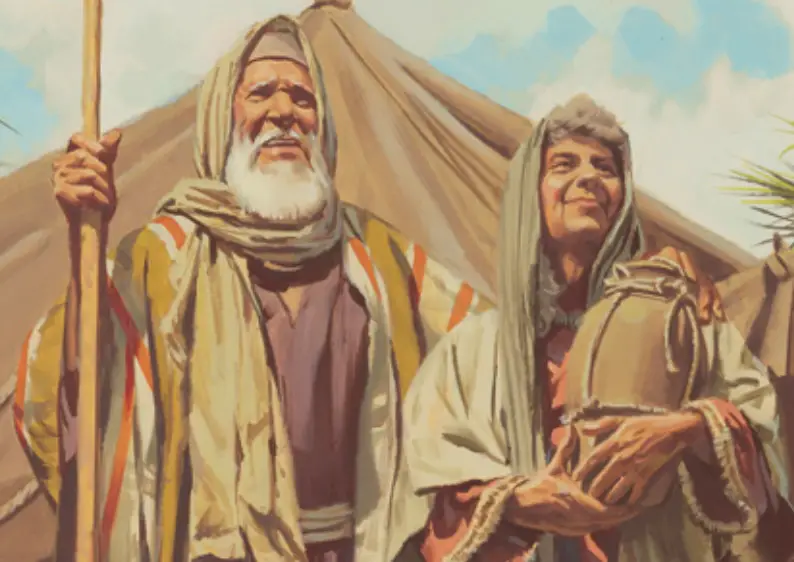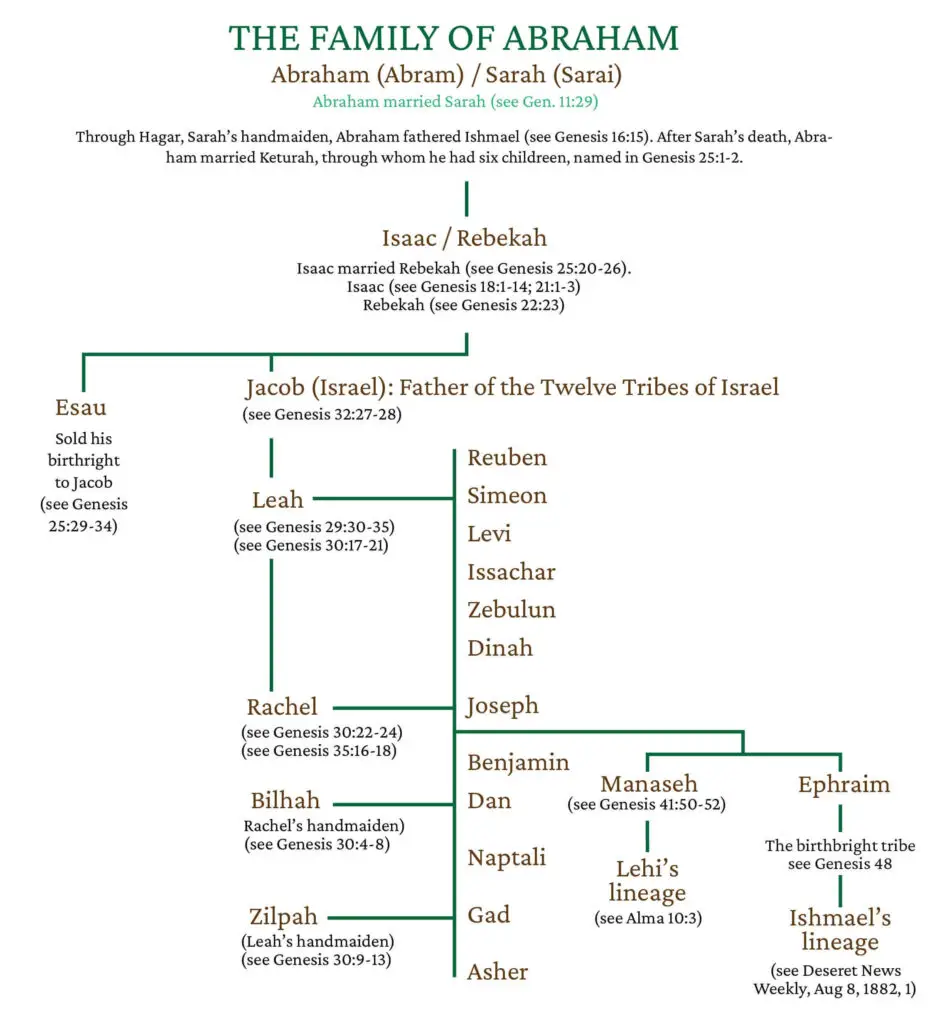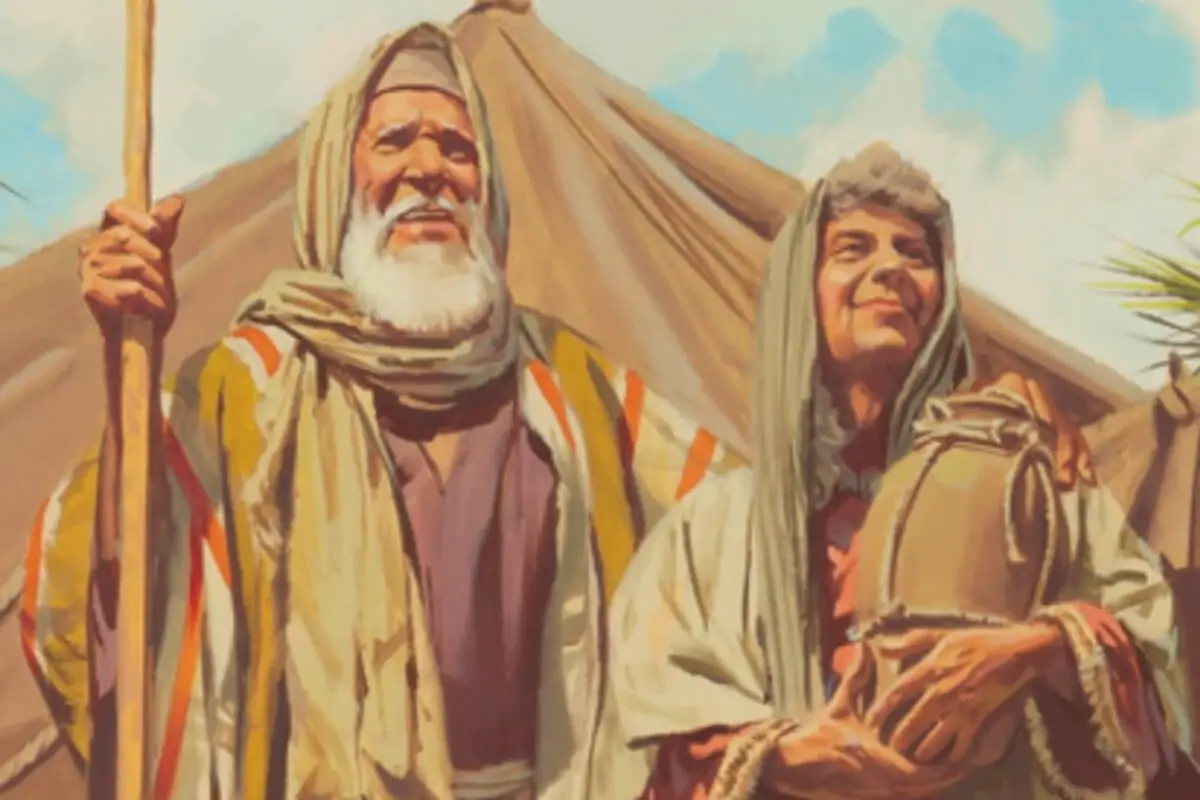Embarking on a historical and theological exploration of the journey of two legendary biblical figures, Abraham and Sarah, we invite the audience to dive deep into the chronicles of an era that stands as the genesis of countless nations and generations. Coloring the canvas of human narrative through their unique roles and offspring, Abraham and Sarah’s lives have contributed notably to shaping sociopolitical structures and faith doctrines across borders.
Amid the intricate intertwining of theology, history, and archaeology, their narrative unearths multiple vistas of understanding about the primal human past, offering distinct perspectives that resonate with religious circles and academic, historical, and scientific discourses.
Table of Contents
- Origins of Abraham and Sarah
- The Immediate Offspring of Abraham and Sarah
- Lineage and Descendants
- Calibrating the Abraham and Sarah Family Tree with Modern Knowledge
- Related Questions
Origins of Abraham and Sarah
Genesis Pioneers: The Significance of Abraham and Sarah
Among the primary architects of religious thought, Abraham and Sarah hold positions of unprecedented importance from a historical, spiritual, and cultural perspective. Abrahamic religions, including Judaism, Christianity, and Islam, recount their narrative with reverence, recognizing them as seminal figures embarked on a sweeping spiritual journey.
Abraham is patently recognized as the patriarch of monotheism. Born in Ur, ancient Mesopotamia (present-day Iraq), the scriptures chronicle his journey from polytheistic beginnings to an unwavering conviction in one supreme being.
The essence of Abraham’s life is characterized by the covenant he entered into with God – one that would set the stage for the birth of monotheistic faiths and influence millions of lives across centuries. This covenant, couched in promises of progeny and prosperity, often tested Abraham’s faith and loyalty, providing cultural and moral texts important today.
Beyond the patriarch, his wife Sarah, initially Sarai, emerges as an equally transformative figure. The story of Sarah, trafficked into Pharaoh’s court, only to be returned to Abraham, bespeaks resilience, raising important concepts regarding faith, feminine strength, and the power of a divine promise.
Sarah’s significance cannot be overstated – her journey from barren to blessed represents resilience and grit. Her life’s central event, the birth of Isaac at an advanced age, underlines the miracle of faith, often used as a beacon of hope.
Sarah’s narrative is pivotal when she persuades Abraham to father a child (Ishmael) with her handmaid, Hagar. This decision not only portrays her character’s complexity but further shapes the narrative of the Abrahamic lineage.
Their life journeys offer a plethora of symbology, often serving as metaphors for faith, trials, and divine engagement. Abraham and Sarah’s narrative is interpreted differently across Abrahamic religions, yet universally accepted as foundational to these belief systems. The couple shares the spiritual heritage and forges moral and ethical systems that still resonate today.
Abraham and Sarah’s various trials and unwavering faith in adversity underline their significant status within Abrahamic faiths. Their narrative encompasses a series of ‘firsts,’ marking the inception of monotheism, demonstrating the power of unconditional faith and the human capacity to endure in the pursuit of divine communion.
Moreover, their shared narrative presents an intriguing intersection of gender dynamics and spirituality. Abraham and Sarah reiterate a profound truth that spiritual leadership is not solely masculine or feminine but a shared endeavor—a distinctly modern interpretation firmly rooted in an ancient narrative.
Hence, Abraham and Sarah exemplify more than mere ancestral figures in the Abrahamic tradition. They represent the birth of a spiritual paradigm. Their narrative laid the groundwork for the three major religions that dominate the globe today. The significance of their journey is timeless and continues to inspire faith, resilience, and the exploration of spirituality.
Every aspect of their lives—trials, tribulations, sacrifices, and triumphs—adds a riveting chapter to the annals of religious history. Indeed, the lives of Abraham and Sarah underscore how individuals’ covenant with the divine can shape civilizations and belief systems for centuries to come.

The Immediate Offspring of Abraham and Sarah
Progeny of Abraham and Sarah: Scions of the Abrahamic Lineages and their Influence
Expanding on the remarkable journey of Abraham, the patriarch of monotheism, and his wife Sarah, it is essential to elucidate their immediate offspring. These children, fathered by Abraham, germinated the roots of profound immediate and distant lineages. Their narratives and subsequent influence underscore the potency of the Abraham-Sarah saga.
The lineage of Abraham and Sarah is initiated with the birth of their heralded son, Isaac. As prime figures in the Old Testament, the conception of Isaac by a once-barren Sarah is often viewed as a divine miracle, embodying the omnipotent will of the monotheistic God.
This spectacular narrative expounded Sarah’s enduring faith, further anchoring the importance of her transition from barrenness to blessing. Isaac is a pivotal figure, crucial in propagating the Abrahamic lineages and elevating the significance of faith and covenant in theological narratives.
The second significant offspring of Abraham is Ishmael, whom Hagar, Sarah’s handmaid, birthed. While not the immediate offspring of Abraham and Sarah, Ishmael remains an elemental component of the Abrahamic lineage, not through Sarah directly, but certainly through Abraham’s patrilineage.
This unconventional offspring was primarily influenced by Sarah’s decision and the outcome of her resilience in the face of adversity, thereby molding the course of Abrahamic lineage in myriad ways. Ishmael champions an entirely different pedigree of religious and ethnic heritage, inclusive of, but not exclusively, Arab lineages and the Islamic faith.
This narrative of the two sons, born under different circumstances, has had profound theological consequences, influencing diverse lineages by propagating biological descendants and spiritual ones. Isaac’s lineage, as reverberated in Jewish genealogical tradition, perpetuates the Jewish religious lineage, while the Christian ideology recognizes the lineage of faith that streams from Abraham through Isaac to Jesus.
On the other hand, Ishmael, often acknowledged as the forbearer of Arab lineages, is recognized as the progenitor of Prophet Muhammad as per Islamic tradition. As such, he becomes an integral figure in formulating and propagating Islamic lineage and faith.
Delving deeper into their characters, Isaac and Ishmael depict unique narratives that blend intertwining elements of sacrifice, divine intervention, and their unwavering commitment to faith.
These aspects largely contribute to the moral and ethical systems imbued in the Abrahamic faiths. Equality should be emphasized here, as the alignment and significance of each narrative don’t denote superiority. Still, the diversity and breadth of the monotheistic paradigm birthed in the time of Abraham and Sarah.
In conclusion, Abraham and Sarah’s immediate offspring and the stories that emanated from their lives have greatly influenced biological and theological lineages.
This intricate ancestral web, birthed by Abraham and Sarah through Isaac and Ishmael, has shaped civilizations, belief systems, and spiritual ideologies, anchoring the far-reaching implications of this historical narrative rooted in faith, resilience, and unwavering spirituality.
By inspecting the lineages birthed and examining the influence exerted by their immediate offspring, we may better comprehend the depth and breadth of Abraham and Sarah’s journey that resonates in the heart of several modern civilizations and belief systems.

Lineage and Descendants
To continue our examination, it is paramount to take into detailed account the prolific impact of the direct descendants of Abraham and Sarah. Their progeny, Isaac and Ishmael, had significant narratives, which contributed to the unfolding of different ethno-religious identities and the subsequent socio-political situations they informed.
Isaac, born miraculously to Sarah in her old age, is integral in leading the lineage that would later solidify into the Jewish people. As the intended recipient of Abraham’s covenant with God, several traditions and beliefs were concretely formed over time.
This covenant promised the land of Canaan – an essential aspect of the socio-political makeup of the region, underwriting perennial Jewish claims to the land referred to as Palestine or Israel today. This circumcision-based covenant, central in Jewish theology, has wide-ranging socio-political implications, particularly in terms of identity, heritage, and claims over the contested territory.
Perhaps equally noteworthy, the narrative of Ishmael, the son of Abraham born to Hagar, Sarah’s handmaid, provided the essential roots for Arab identity and Islamic beliefs.
Once cast away to the wilderness, the survival of Ishmael and his mother fortifies the formative narrative, underscoring their resilience against adversity – a motif resonant in later Arab and Islamic history.
Furthermore, Islamic tradition extols the virtue of Ishmael as a Prophet. It recognizes him and Abraham as the builders of the Kaaba in Mecca, a significant socio-religious marker symbolizing a point of unity among the global Muslim population.
Thus, the narratives of these half-siblings, Isaac and Ishmael, had an immense impact at regional, social, political, and theological levels. Diverging in separate paths yet united by their origins, these narratives created dynamic, syncretic identities shaping the evolving landscapes of the Middle East and beyond.
Moreover, it is notable how the theological underpinnings derived from these stories were employed to create the distinct socio-political structures that ensued. From laws to customs, these narratives further enriched the distinct cultures crystallizing out of their lineage.
The complexities and nuances in these narratives exemplify how faith and lineage can shape socio-political realities and identities. The descendants of Abraham and Sarah extend beyond genealogical importance – they possess substantial historical importance, embodying narratives of faith, survival, and resilience.
Their stories provide the primary bedrock for developing vibrant cultures, belief systems, and diverse spiritual ideologies that continue to shape today’s world. How their narratives played out then had lasting effects that continue to ripple out across the socio-political landscape of our contemporary world.
Calibrating the Abraham and Sarah Family Tree with Modern Knowledge
Delving deeper into the family tree of Abraham and Sarah, one must recognize the remarkable arch of history and heritage they embodied, bridging antiquity to contemporary societies and shaping the tapestry of several civilizations.
This has stirred great interest, spilling beyond the confines of theology into historical research, archaeological findings, and genetic studies.
Historical data offer a glance into the evolution of Abraham and Sarah’s descendants, offering novel insights into their dispersion and transfiguring these migratory patterns into a broader comprehension of human history.
The Jewish exile, the Islamic Hijrah, and the widespread dispersion of Abrahamic descendants have laid the foundation for extensive socio-cultural development and interchange.
Remarkably, archaeological findings concur coherently with these historical depictions. Excavations across the Fertile Crescent, particularly Mesopotamia and the Levant, have unveiled substantial evidence corroborating with the Biblical tales.
While the city of Ur, Abraham’s birthplace, has been unearthed, Tell-el-Mukayyar in Southern Iraq has provided conclusive evidence of its antiquity. Artifacts and architectural remnants allow scholars and enthusiasts alike to witness an intimate panorama of Abraham and Sarah’s society and emphasize the plausibility of their accounts.
Modern genetics has further accentuated the lineage’s understanding of Abraham and Sarah. Genetic testing of diverse populations across the globe has revealed a standard genetic marker, often referred to as the “Cohen Modal Haplotype.”
This marker is predominantly found in the Jewish Kohanim lineage, purportedly descendants of Aaron, Moses’ brother and son of the Levite tribe, who have their roots in the Abrahamic family tree. This remarkable genetic continuity, undiluted throughout millennia, not only corroborates the historical narratives but also the direct descendant claim of many to Abraham and Sarah, bridging the gap between genetics and religious beliefs.
Notwithstanding, the narratives of Abraham, Sarah, Isaac, and Ishmael extend beyond merely an ethno-religious chronicle to open up a discourse on reconciliation and unity emanating from a common ancestry.
For Christian, Jewish, and Muslim followers, Abraham’s willingness to sacrifice his beloved son, mirrored in Sarah’s sacrifices, speaks volumes of faith and submission. This monotheistic tether perhaps serves as a counter-narrative to conflicts and divisions.
Finally, dissecting the Abraham and Sarah family tree and aligning it with modern knowledge from history, archaeology, and genetics has animated the rich cultural and religious traditions sown by this couple thousands of years ago.
Their narratives inspire faith, resilience, and sacrifice, shaping and profoundly influencing multiple lineages and spiritual ideologies even today. The intertwining of science and faith in analyzing their lineage also underscores the enduring relevance of Abraham and Sarah in the human quest for understanding heritage, faith, and identity.

Our journey through the narratives of Abraham and Sarah has led us on an intricate path where the past meets the present; tradition intersects science, and relic narratives find significance in contemporary contexts.
With explorations from their origins to their immediate offspring to their vast lineages, the evolving comprehension of their stories contributes significantly to our knowledge of human socio-political evolution. Calibrating this deep-seated family tree with modern knowledge opens up new avenues of understanding and interpretation.
It brings us face to face with the exhilarating and often challenging endeavor of finding harmony, sometimes discord, yet watching the interplay between ancient texts and today’s insights results in an intellectually fruitful exploration.
The Hummel Family is a website all about Family History research. We focus on Swedish, German, English, Scottish, and American Genealogy. We also discussed Asia and China, as we had ancestors who spent many years in China.
You are welcome to join us and become part of our community by signing up for our FREE newsletter, The Hummel Family; sign up by clicking here.
Check out our Youtube Channel, Family History Buzz, by clicking here.
Related Questions
How Reliable Is The Genealogy Website FamilySearch.org?
FamilySearch.org is a very reliable genealogy website. It is considered one of the best genealogy-focused research websites in the world. One of the best things about this is that the website is free for everyone, regardless of affiliation or religion. The website has millions of genealogy records, which have been updated daily. It is also a collaborative website, and you may find relatives ready to work on your family line so you can tap into the work they have already done.
You can discover more by reading How Reliable Is The Genealogy Website FamilySearch.org? by clicking here.
What Does Swabia Mean? About Swabian German
Swabia is a region in southern Germany; the people in this region speak Swabian German. Though the region is today part of modern-day Germany, historically and culturally, it was different. The name Swabia came from the Duchy of Swabia.
You can discover more by reading What Does Swabia Mean? About Swabian German by clicking here.
A History of The Kingdom of Württemberg – Germany
The Kingdom of Württemberg existed from 1805 to 1918. The Kingdom had four different Kings. Though the Kingdom of Württemberg is now part of present-day Germany, during its existence, the alliances of the Kingdom changed. The last King of Württemberg was forced to abdicate in 1918.
You can discover more by reading A History of The Kingdom of Württemberg – Germany by clicking here.

